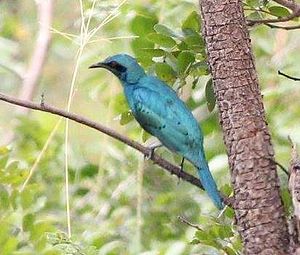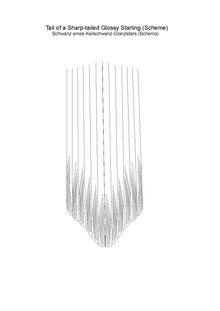Wedge-tail gloss star
| Wedge-tail gloss star | ||||||||||||
|---|---|---|---|---|---|---|---|---|---|---|---|---|

Wedge-tailed gloss star ( Lamprotornis acuticaudus ) |
||||||||||||
| Systematics | ||||||||||||
|
||||||||||||
| Scientific name | ||||||||||||
| Lamprotornis acuticaudus | ||||||||||||
| ( Bocage , 1870) |
The wedge-tailed glossy starling ( Lamprotornis acuticaudus ) is a species of the genus Actual glossy starlings ( Lamprotornis ) in the family of starlings (Sturnidae) from the order of the passerine birds (Passeriformes), which is about 23 cm tall in Africa south of the Sahara . There are currently two known subspecies. It has a greenish shimmering metallic shimmering plumage which is given a slightly bluish tint on the belly and flanks and a wedge-shaped tail that gave it its name. Its eyes are red to orange. The main distribution area is in the countries of Angola, Zambia and the southern Democratic Republic of the Congo. It feeds mainly on fruits.
Taxonomy
In science there is still the assumption that the wedge-tailed starling ( Lamprotornis acuticaudus ) forms a super-species with the Lamprotornis chloropterus. The wedge-tailed gloss star ( Lamprotornis acuticaudus ) is divided into two subspecies: Lamprotornis acuticaudus acuticaudus
Lamprotornis acuticaudus ecki
features
Physique and plumage
The 21 to 25 cm large wedge-tailed gloss star ( Lamprotornis acuticaudus ) has a fully grown weight of 61 to 76 grams and an average wing length of 12.3 cm. It has so-called structure feathers, which produce their colors without pigments by refraction. The special shine is caused by the melanosomes embedded in the structure of the feathers in the melanocytes , which are under a keratin film . What makes these melanosomes special is their not only rod-shaped, but also hollow shape. The nominal shape of the wedge-tailed gloss star (L. a. Acuticaudus) has a greenish, metallic, shiny plumage on the head, neck, neck and upper chest as well as along the back and the reins between the beak and eyes are black with a light bluish sheen and less clear Demarcation. The rein runs below the eye and merges into the round bluish, shiny ear covers that extend into the area of the cheeks. The eponymous tail of the wedge-tailed gloss star is about 8.2 to 10.4 cm long and runs in a clearly delimited wedge shape from the outer tail feathers T6 inward to the tip of the tail T1. The T6 springs are about 70% of the length of the T1 springs. In the case of the outer tail feathers, the structure of the feathers slides slightly outwards. Its wings also appear shiny green and the feathers of the wings have a narrow purple edge, while the shoulder area appears in a slightly bluish tone.
The L. a. Overall, ecki appears in bluish green tones, its flanks appear in a rather darker blue and otherwise corresponds to the appearance of the nominal shape.
eyes
The iris of the adult glossy wedge-tailed star is red (♂) to orange (♀). In the juveniles, these are brown at first and then, with the development of the young bird, they first turn yellow until they reach the color of the adult bird. Like most bird species, except for the nocturnal birds, the green-tailed starlings see their environment differently than we humans. In contrast to humans, the star has four and not just three types of photoreceptors (also called photoreceptors ) on the retina for color vision . In addition to the thinner rod-shaped receptors responsible for black and white vision , four cone-shaped receptor types are responsible for perception in starlings (tetrachromatic vision). Three of the four cone-shaped receptor types are responsible for the red, green and blue areas of light (trichromatic vision) that are visible to humans. The fourth receptor is responsible for the perception in the area of ultraviolet light , which is not visible to humans. The incidence of light stimulates the various types of receptors within the strongly folded membranes, which are provided with different colored oil droplets, with different intensities. The responsible receptors react more or less strongly to the different wavelengths of light, so that the different colors and hues are perceived. The additional UV receptor compared to humans allows starlings to perceive our environment in a much more differentiated or different way. With the help of the UV receptors, the star is able to better and more easily recognize differences in the conspecifics, the degree of ripeness of the fruit or traces that we cannot see.
Vocalizations
The sound utterances are even, fluid, in high-pitched warbling tones, mixed with gurgling and cooing sounds. While they are eating their food in the trees, they make conversational chuckling noises. In groups, the calls are shrill and flowing.
Juvenile
The juveniles of the nominal form are brown in color and the wing feathers have a gold-green sheen and do not have a purple border. The tail appears blue-green. In contrast, the juveniles of Lamprotornis acuticaudus ecki are more grayish-brown.
Habitat and Distribution
Lamprotornis acuticaudus acuticaudus ( Bocage , 1870): Its distribution area is in central, northern and eastern Angola, western and northern Zambia, the southern Democratic Republic of the Congo and north-western Tanzania.
Lamprotornis acuticaudus ecki ( Clancey , 1980): Its distribution area is in southern Angola and northeastern Namibia, as far as the Okavango Valley. as well as in the extreme northwest of Botswana.
Its approximately 1.54 million km² large habitat consists mainly of extensive Miombo deciduous forest and Brachystegia species in higher areas, such as in Angola between 900 and 1700 m above sea level and in the river valley of the Kunene with mopane trees ( Colophospermum mopane ). In more densely forested areas, such as river valleys, open areas such as tree savannas, plains or flood plains and marshland are usually nearby. In Zambia, the habitat largely corresponds to that of the shiny brass star ( Lamprotornis chloropterus ), with drier, open, lightly forested savannas, bush and farmland.
Way of life and behavior
During the breeding season, the wedge-tailed starlings appear in pairs. The rest of the year they form in smaller groups of up to 50 individuals. It seems to be a sociable bird and sometimes forms groupings with the brass star ( Lamprotornis chloropterus ) and the green-tailed star ( Lamprotornis chalybaeus ).
Its diet is mostly on the ground and consists of fruits and insects. The consumption of fruits from the genus persimmon ( Diospyros ) in the ebony family (Ebenaceae), such as that of Diospyros kirkii in Angola and in Namibia the star apple ( Diospyros lycioides ), also called monkey plum, is reported. Insufficient information is currently available on nutrition.
Reproduction
The wedge-tailed gloss star builds its nest out of grass, feathers and hair on the floor of old burrows of woodpeckers (Picidae) and African bearded birds or natural burrows in old trees and tree stumps.
Danger
The wedge-tailed gloss star is not considered an endangered species in its distribution areas. Its population is considered stable. A verification is hardly possible, as a differentiation from other species in the wild is extremely difficult. However, since the distribution areas are extremely large, it is classified by the IUCN as not endangered (least concern).
Systematics
Overall, the data situation can be viewed as extremely poor. The following is an excerpt from the family tree based on IJ Lovette and DR Rubenstein.
|
|
|
|||||||||||||||||||||||||||||||||||||||
|
|
literature
- Charles Hilary Fry , Stuart Keith , Emil K. Urban (Eds.): The Birds of Africa. Volume VI: Picathartes to Oxpeckers. Christopher Helm, London 2000, ISBN 978-01-21373-06-1 , pp. 608-609.
- AJFK Craig, CJ Feare: Family Sturnidae (Starlings). In: J. del Hoyo, A. Elliot, DA Christie (Eds.): Handbook of the birds of the world. Volume 14: Bush-shrikes to Old World Sparrows. Lynx Edicions, Barcelona 2009,
- Rafael Maia, Dustin R. Rubenstein and Matthew D. Shawkey in: "Key ornamental innovations facilitate diversification in an avian radiation". Biological Sciences - Evolution: PNAS 2013 110 (26) 10687-10692; published ahead of print June 10, 2013, doi : 10.1073 / pnas.1220784110 .
- GE Hill & KJ McGraw (Eds, 2006): Bird Coloration. Vol. 1: Mechanisms and Measurements; Vol. 2: Function and Evolution .
- IJ Lovette, DR Rubenstein 2007: A comprehensive molecular phylogeny of the starlings (Aves: Sturnidae) and mockingbirds (Aves: Mimidae): Congruent mtDNA and nuclear trees for a cosmopolitan avian radiation. In: Molecular Phylogenetics and Evolution. 44, No. 3, pp. 1031-1056. Elsevier, September 2007, DOI: 10.1016 / j.ympev.2007.03.017 . ( online PDF ( Memento from June 27, 2010 in the Internet Archive )).
- Hockey PAR, Dean WRJ and Ryan PG 2005. Roberts - "Birds of southern Africa", VIIth ed. The Trustees of the John Voelcker Bird Book Fund, Cape Town, Biodiversity explorer / iziko museums of Cape Town "The web of life in southern Africa ". ( Online )
- The IUCN Red list of threatened species. Version 2015.2. ( Redlist ).
Web links
https://www.flickr.com/search/?text=Lamprotornis%20acuticaudus
Individual evidence
- ↑ a b c d e f g CH Fry, S. Keith, EK Urban: The birds of Africa. Volume VI. Academic Press, London 2000. pp. 608-609.
- ↑ Rafael Maia, Dustin R. Rubenstein, Matthew D. Shawkey: Key ornamental innovations facilitate diversification in an avian radiation . In: Proceedings of the National Academy of Sciences . tape 110 , no. 26 , June 25, 2013, ISSN 0027-8424 , p. 10687-10692 , doi : 10.1073 / pnas.1220784110 ( pnas.org ).
- ↑ a b AJFK Craig, CJ Feare: Family Sturnidae (starlings) . In: J. del Hoyo, A. Elliot, DA Christie (Eds.): Handbook of the birds of the world. Volume 14: Bush-shrikes to Old World Sparrows. Lynx Edicions, Barcelona 2009
- ↑ Frederike Woog: See and be seen - color vision of birds. in: The falcon. - Journal for Bird Watchers 5/2009. ( Online ).
- ^ A b Roberts - Birds of southern Africa (Lamprotornis acuticaudus): ( Lamprotornis acuticaudus ) . biodiversityexplorer.org, 2015. Retrieved April 5, 2015.
- ↑ BirdLife International (2015) Species factsheet: Lamprotornis acuticaudus . ( [1] ). Retrieved September 2, 2015.
- ↑ Irby J. Lovette & Dustin R. Rubenstein 2007: A comprehensive molecular phylogeny of the Starlings ( Memento of the original from November 17, 2015 in the Internet Archive ) Info: The archive link was inserted automatically and has not yet been checked. Please check the original and archive link according to the instructions and then remove this notice. .columbia.edu, 2015. Retrieved March 22, 2015.

